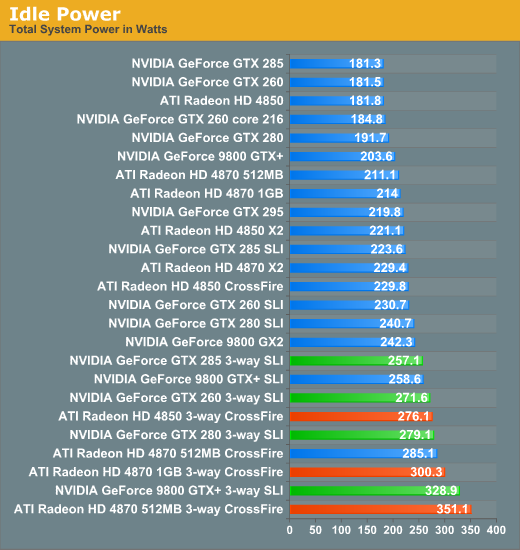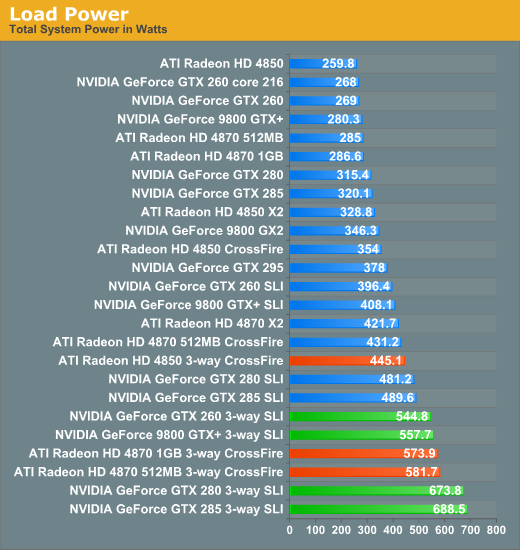MultiGPU Update: Does 3-way Make Sense?
by Derek Wilson on February 25, 2009 2:45 PM EST- Posted in
- GPUs
Power Consumption
No surprises here really. 3-way hardware requires more power at idle and load. Remember that these numbers are total system power consumption, but that these numbers are run with the 3dmark Vantage POM shader test. This means the rest of the system isn't pushed very hard at all. Depending on the game, you could expect real load power draw to be 50 to 100W higher.
While NVIDIA hardware seems to handle idle power a bit better, at load 3-way SLI tends to require much more than 3-way CrossFire. But this is in line with what we saw with 2-way solutions as well.












46 Comments
View All Comments
magnusr - Saturday, February 28, 2009 - link
Got my second 4850. Huge fps upgrade in 1920x1080. But noise during gaming has gone up. Idle just a bit.It would have been nice if you added noise numbers. Since some would probably prefer getting a fast single gpu like nvidia 285 instead of 2x4850/4870 due to possibly lower noise levels.
taltamir - Saturday, February 28, 2009 - link
the following statement is made:It's very difficult to really collect high quality quantitative data that shows microstutter, as the only way to really get a good idea of what's going on is to analyze raw frame data on a per frame basis (which you can't get with FRAPS)
This is incorrect, FRAPS can capture those, its in the settings, it gives exact MS "time" of each frame, and it gives them in order, in a csv file. You can create a function showing the difference between each pair, giving you the ms per frame, and you can analyze that data.
please check this thread in anandtech:
http://forums.anandtech.com/messageview.aspx?catid...">http://forums.anandtech.com/messageview...=31&...
kpgoebel - Friday, February 27, 2009 - link
I just finished reading both pieces - great stuff. the analysis was dense but your pace kept it moving.I use three 20" samsungs for my home workstation that doubles as a flight sim trainer since I took up flying. i added two 880GT's to a Q6600 quad core system, in hopes that it could handle triple 1600X1200 screens for accurate flight control response. it's only proven reliable with the textures turned down to medium or low.. which is a bummer because i've invested in some top-notch sceneries.
any chance you guys will offer some analysis for multiple monitor gaming setups?
orionmgomg - Thursday, February 26, 2009 - link
Thank you for this great article!So much information, and very helpful to get an idea of the where to spend money on a build and where the price/value margins lie.
I cant wait for the Quad shoot out!
PS: Does anyone know if the ASUS Rampage II Extreme is the only X58 Mobo available right now that fully supports X3 PCIe 2.0 x16?
The Other ASUS boards say they support: PCIe 2.0 x16/PCIe 2.0 x16/ or PCIe 2.0 x16/PCIe 2.0 x8/PCIe 2.0 x8...
Contemplating 3 Way SLI...
Zorro3740 - Thursday, February 26, 2009 - link
For triple and quad cross to really be worthwhile a high refresh rate LCD can be a great way to benefit from the huge headroom in performance given from multi GPU setups. I have several PCs with triple crossfire Radeon 4850s on 60 hertz displays. A game like Devil May Cry 4 comes to mind. If you can sustain that ultra high 120 frame limit of these new displays the value of multi GPU will suddenly become that much more apparent. I sure could easily with my Phenom 2 920 or I7 920. With max settings at 1080p you get as much as 200 frames or more. It just moves so smooth at frame rates higher than 60. I imagine it would be similar to the 99 hertz refresh rate of my 24" CRT at 1080p. I stopped using that display because of its dimness but it gave me a damn good idea of what a real fast 120hz LCD might do. How about 120 FPS with 24 sample FSAA in Devil May Cry 4? I'm sure there are many instances where 120 hertz will make a huge difference for Multi GPU enthusiasts.I highly recommend that somebody test their multi GPU rig with a 120hz LCD HDTV and tell us about how smooth the action is and how clear it is with higher levels of FSAA. It is a shame that 120hz is not here in the PC monitor world. I have the HP LP3065 that does 2560 * 1600 @ 60hz. I would trade that in for a 120hz 1080p or 1200p LCD model in a flash if I could if it had a high quality backlight. I HATE that the world is becoming a TN world when it comes to monitors. We need 120 hz 8 bit panels and we need to just get the hell away from shoddy 6 bit monitors with light bleed among other unacceptable faults.
Anyhow I really enjoyed the article and confirmed to me that for the games I play the 4850 is a good multi GPU choice. I just would have liked to see more of an emphasis on future developments like 120hz LCDs and higher levels of FSAA in particular at "lower" resolutions like 1920 * 1080 and 1920 * 1200 with 512 meg setups and 1 gig setups. Multi GPU 4850s are way more affordable than 30" monitors and some people will definitely "settle" for nice 24" 8 bit panels like the Westinghouse L2410NM that rock at 1920 * 1200.
far327 - Thursday, February 26, 2009 - link
Would like to others comments including authors on the differences between some of the numbers of the charts on Anandtech and TheGuruof3d http://www.guru3d.com/article/core-i7-multigpu-sli...">http://www.guru3d.com/article/core-i7-m...li-cross...I think an overclocked CPU would of been a much more well rounded approach to this article. Even thought the performance gains aren't huge, let's face it, most people hardcore enough to game with 3 GTX 280/285's is probably overclocking there CPU as well.
chizow - Thursday, February 26, 2009 - link
Haven't really dug into the review yet Derek, but meant to suggest this in the last article. Is it possible to do something about the text in the bar graphs? Its just overly cumbersome trying to make sense with all the extraneous text in there. Some suggestions:1) Perhaps you're required to put Vendor + Brand for each config, but can we get an icon for Nvidia or ATI instead of ATI Radeon or Nvidia GeForce for every single line item?
2) Color code the relevant data for each line item to differentiate. For example:
Nvidia GeForce [green]GTX 285 3-way[/green] SLI
ATI Radeon [red]HD 4870 3-way[/red] CrossFire
Would go a loooooong way into making those graphs easier to parse and digest. Back to reading, thanks.
OblivionLord - Thursday, February 26, 2009 - link
What about the thought of 3way 100% scaling with Lucid Hydra?Why not make mention that if that becomes a reality, then you will infact get what you pay for.
DerekWilson - Thursday, February 26, 2009 - link
I love the idea of Lucid and their Hydra technology ... but it isn't here yet. I enjoy writing articles about what their technology could mean and how beneficial and amazing and awesome it would be ... but it's not here yet and we haven't had a hands on chance to see for ourselves that it works as advertised.until it's out, SLI and CrossFire are the best we've got and the focus of our articles.
maybe we'll run into Lucid again at GDC and write up more cool stuff about Hydra though ...
Denithor - Thursday, February 26, 2009 - link
Guru3D did an article at the i7 launch showing how well i7 scales with multiGPU setups compared to C2D & C2Q. Night & day difference, to tell the truth, i7 just pushes the multiGPU rigs much better than the older architecture can.My question is this: how does PhII compare to i7 on the multiGPU front? I'd love to see some benching done at high resolution with 2/3/4 card setups on the two CPU architectures to see how they look.